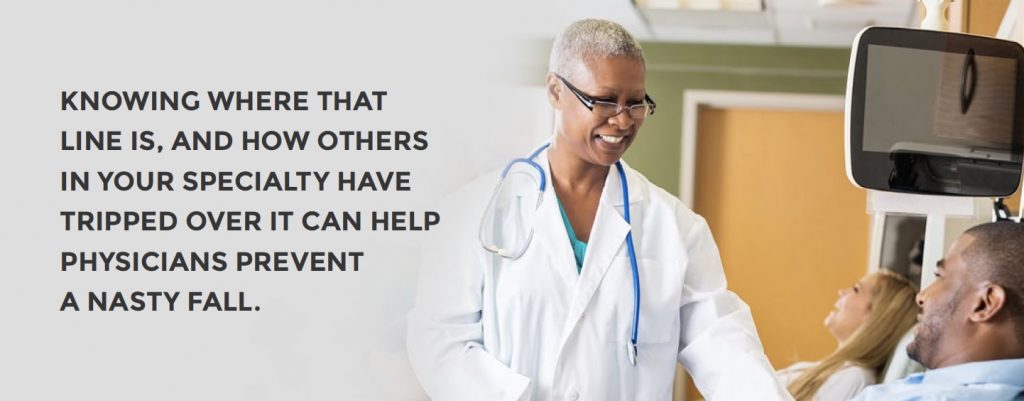Of Fleas, Blades, and Shrinks:
Of Fleas, Blades, and Shrinks:
How the Potential for Boundary Violations Differs by Specialty
Each specialty seems to have its own moniker. Surgeons are known as “blades” for obvious reasons. Psychiatrists are “shrinks,” a reference, some say, to head shrinking. And since internists have to stay with dying patients long after other specialists have left, they are often referred to as “fleas,” which are generally considered “the last ones to jump off a dying dog.”
But for all the silliness around nomenclature, each specialty does have distinctive characteristics, which may explain why so much has been written about the ways in which personality types might or should influence people’s choice of medical specialty.
What warrants more research, suggests Dr. Stephen Schenthal, Founder of PBI Education is how various specialties tend towards specific boundary violations. After more than 20 years of working with clinicians who have been sanctioned for such violations, Schenthal has noted a degree of consistency not between personality types and specialties, but between those who work in certain specialties and the boundary violations they are most vulnerable to.
Schenthal stresses that every situation is unique and that almost always a practitioner’s personal history is the primary factor in any boundary violation. But each specialty not only attracts certain types of people, it also involves certain kinds of interactions with patients and staff that predispose people to cross particular boundaries. While Schenthal’s observations are based on his own years of experience, rather than statistically valid research, he believes they can help some practitioners avoid problems their peers have succumbed to.

Consider internists. By virtue of their practice, which often ranges from young adult to geriatric, general practitioners tend to see the same patients over long periods of time. Not surprisingly, they develop relationships with these longer-term patients, often coming to see them as friends. And yet in one very important respect the doctor-patient relationship is the antithesis of a friendship: friends see each other as equals, whereas physicians and patients are anything but equal. At least as far as the professional relationship goes, the doctor is in a superior position, with contractual, fiduciary responsibilities. Based on their training and licensing, doctors order tests, prescribe medicines and ultimately are paid for their services. There is none of the reciprocity inherent in a friendship.
“The challenge for internists is to maintain an appropriate degree of elevation and authority,” says Schenthal. “What happens in a boundary violation is that the space between the physician and the patient collapses, and the physician comes to see himself on equal terms with the patient.” At that point it is all too easy for the doctor to become, or be seen as exploitive. In effect, two contradictory relationships have developed—one personal, one professional—and when they come into conflict, as they almost inevitably do, the patient is likely to feel betrayed, especially if the friendship has become romantic or sexual.
Not all that long ago, a degree of paternalism insulated internists from any sense of equality with patients. But dissatisfaction with paternalism has grown dramatically over the years, and patients now generally expect more of a partnership with their doctor. Moving beyond paternalism “raises new complexities,” however, notes an article in the British Medical Journal. “Because a partnership between patient and doctor can take different forms, it is not intuitively apparent what this model would look like.” No matter what form it takes, nothing can change the fact that it is the physician who is ultimately responsible for the outcome of the relationship. Both doctors and patients forget this at their peril.
Surgeons have very different relationships with their patients, often seeing them for only brief periods of time before and after surgery. It is therefore more common for surgeons to run into trouble with people on their surgical teams than it is for them to cross boundaries with patients. Both surgeons and ER doctors tend to work for years with the same group of professionals, often under intense conditions, and it is not unusual for these team members to develop strong, family-like, even intimate feelings for each other. Once again, the danger arises when doctors forget the inherently unequal nature of these relationships.
At the opposite extreme, surgeons and ER doctors also can cross boundaries by abusing the power differential between themselves and their team. Older physicians in particular sometimes fail to recognize how much the culture has changed and that what used to be considered acceptable behavior now qualifies as sexual harassment or creating a hostile work environment.
ER doctors face yet another challenge, because they deal with patients who are generally suffering from severe emotional stress and who are likely to feel especially vulnerable. With no chance to build any kind of trusting relationship, the doctor’s best protection in these cases, says Schenthal, is the use of a chaperone. All too often, doctors dismiss the use of chaperones because the exam they are conducting is not “intimate,” or because the patient says they don’t want or need a chaperone. “What physicians have to remember is that the chaperones are there to protect them, as much as the patients,” says Schenthal. If a patient complains that her doctor has inappropriately touched her during an examination, the doctor has no way to refute the claim if there is no objective third party in the room.

Psychiatrists often decide on their specialty out of a strong desire to understand and care for troubled patients. Such compassion can be a valuable trait in a friendship, but it is a potential source of trouble in the doctor-patient relationship. “All too often I see psychiatrists over-extend themselves out of a deep desire to relieve a patient’s suffering,” says Schenthal. They may loan money or make other arrangements outside of the therapeutic relationship that they feel will be helpful. But by doing so they are essentially crossing the boundary between professional and personal relationship. Some vulnerable patients end up feeling betrayed when they eventually realize that the doctor’s “kindness” does not signify something deeper; others sense weakness and seek to manipulate the psychiatrist. And of course there are times when both patient and doctor allow the personal to overwhelm the professional and enter into the kind of inappropriate relationship for which the doctor can lose both her license and even her freedom.
Neither personality nor choice of specialty dooms anyone to violating a professional boundary, of course, and most practitioners go through their whole careers without incident. But the best way to avoid problems is to be aware of how easy it is for anyone in any specialty to cross the line between personal and professional. “Knowing where that line is,” concludes Schenthal, “and how others in your specialty have tripped over it can help clinicians prevent a nasty fall.”
View Other Posts
- New Data Suggest Remedial Courses Reduce Recidivism
- Summer School: Reduce Stressors, Avoid Burnout
- Don’t Wait Until it is Too Late: How a Personalized Protection Plan© Decreases Violation Potential
- The What, Why, When, and How of Remedial Educational Interventions
- Revisiting Moral Courage as an Educational Objective
